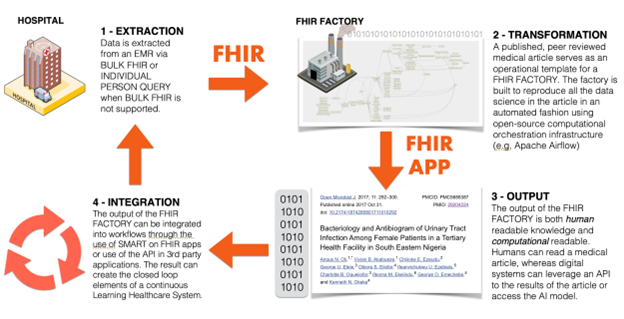 By Jeff Strada, The George Washington University – Milken Institute School of Public Health
By Jeff Strada, The George Washington University – Milken Institute School of Public Health
LinkedIn: Jeff Strada
New tools have been developed for researchers and clinicians to access electronic health record (EHR) data in a more productive manner. An awardee of a 2020 ONC Leading Edge Acceleration Project (LEAP) in Health IT, MedStar Health Research, worked in tandem with HealthLab and Georgetown University Medical Center to develop products. This trio created two new data tools which are part of MedStar’s Fast Healthcare Interoperability Resources (FHIR) Factories: An Evolving Digital Architecture to Scale Health Research Project. This team designed and created FHIR Factories. FHIR Factories are advanced data platforms that allow researchers easy access to data in standardized formats. In addition, these FHIR Factories allow researchers to conduct extraction and analysis at scale which improves efficiency. The data factories leverage FHIR to create actionable insights by transforming the data by accessing application programming interfaces (APIs). The beauty is that this improved knowledge is used for clinical care at hospitals and clinics to improve patient care and outcomes.
These two tools can be accessed through ONC’s GitHub repository, but the site requires a registration. The two tools are the Bugs & Drugs FHIR Factory and the Trend Engine FHIR Factory. These tools were designed to leverage standardized Health Level Seven International ® (HL7) FHIR data.
The FHIR Factories allow for iterative and automated extraction of data, transformation, and integration of the data using the FHIR API. The infrastructure of the FHIR Factories provide end-to-end closed loop automation. These tools are open-source and open-standard which encourages interoperability. Moreover, the introduction of HL7’s FHIR standard into the data factories produces a roadmap to interoperable data extraction and analysis by using the FHIR Factory Platform. Since the tools use FHIR, they can be used with any vendor in the industry.

Figure 1: FHIR Factory overview including four iterative steps: (1) extraction; (2) transformation; (3) output; and (4) integration. In step 1, patient data can be extracted with bulk FHIR, which pulls large quantities of data via the FHIR API, while an individual person query would extract data one person at a time.
Bugs and Drugs FHIR Factory with SMART-on-FHIR app
The Bugs and Drugs FHIR Factory delivers almost real-time, continuous antibiograms that identify which drugs should be prescribed for treating urinary tract infections. Antibiograms are panels that show clinicians how susceptible certain microorganisms are to antimicrobial drugs. They use these panels to select which antibiotics to give to a patient while they are awaiting microbiology cultures and susceptibility results. After receiving susceptibility results, a physician might change the course of antibiotics to one that will better target the pathogen.
The SMART app works with OpenEMR and uses an antibiogram developed by the FHIR factory for the provider. The provider can see statistical significance and power calculations in the table results. The magic happens as the antibiogram updates as new information is added to the EHR. This allows the antibiogram to stay ahead of the published literature with an automated process. Providers can also use this to track local and regional antibiotic resistance which helps inform their stewardship programs. Researchers and clinicians can modify the Apache Airflow based FHIR Factory which will allow the tool to be used to create antibiograms for other types of infections of interest.
The SMART app created to work with OpenEMR takes an antibiogram created by the FHIR Factory and shows it to the provider; power calculations and statistical significance are included in the results table. The antibiogram will update as new information is added to the EHR, which means it can be more up-to-date than traditional published research. It can also enable the tracking of local and regional antibiotic resistance. Modifying the Apache Airflow based FHIR Factory can enable the tool to be used to create antibiograms for other classes of infections as well.
What Does the Future Hold for FHIR Factories?
Trend libraries could be created and replicated for a variety of diseases, resource utilization, medication use, and more. These libraries can leverage EHR data to monitor illness rates, utilization of health services, laboratory testing, and clinical diagnoses by area of interest.
These tools can be used to create real-time research articles which can easily scale health care research. These articles can be automatically rewritten each time the data is refreshed, thereby creating results that are near real-time and virtually always up-to-date. The articles can include statistics, simulations, and visualizations. The future holds boundless potential for FHIR Factories by leveraging the expertise, infrastructure, and interoperability promised by Health IT.
